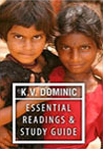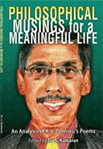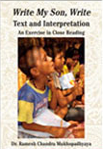Details of Critical study
Multiculturalism in India: A Wonder to the World
Year Of Publish:
Multiculturalism in India: A Wonder to the World
K. V. Dominic
(Paper presented at KL University, Vijayawada, A.P.,
India on 29th March 2016 which won great applause from the entire enlightened audience)
Â
The concept of multiculturalism originated in the 1970s and was used in Canada for the first time to tackle the problem of immigrants. Then it spread to other countries like Australia, USA, UK and some countries in the European Union where immigrants of different countries of the world lived and settled. Since assimilation and homogenization failed, multiculturalism has become inevitable and thus the governments adopted it as an official, political policy.
Multiculturalism is defined as the state of co-existence of diverse cultures. Culture includes, racial, religious, linguistic, etc. which may have differences and distinctions in customary behaviours, cultural assumptions and values, patterns of thinking and communicative styles. It also aims at the preservation of different cultures and their identities within a unified society as a state or nation.
‘Multiculturalism’ is now used not only to define disadvantaged and maginalised groups like tribals, linguistic-cultural-religious minorities, LGBT, disabled, etc., but also immigrants who may come under ethnic, religious minorities as well as minority nations and indigenous peoples.
Multiculturalism is applied by the government, philosophers, politicians, writers, critics and scholars for human society alone, but to me it includes non-human beings, plants and the planet itself. As we say that human beings in a society or nation should live as members of a family irrespective of their race, religion, caste, language or gender, it is necessary that we should live in harmony with other beings, both animals and plants. To me this universe is a big concert or symphony, a harmony of diverse notes. All creations play their role in concordance, but man tries to play discordant notes–stands against the rhythmic flow of the system. Let me quote a few lines from my poem “Multicultural Harmony†published in my poetry book Multicultural Symphony:
Multiplicity and diversity
essence of universe
From atom to the heavens
multiculturalism reigns
This unity in diversity
makes beauty of universe. (Dominic, Multicultural Symphony 15)
As man is the latest evolutionary being, he should respect other beings and plants which have greater legacy to claim in this universe. Human beings can’t live independent of non-human beings or plants. Hence when we try to eliminate or destroy non-human beings and plants we are eliminating ourselves from this planet. Let me quote again from “Multicultural Harmonyâ€:
You may live here
Let other things also live
Since you are selfish and greedy
you take more than
what is due to you
Other beings struggle for necessities
whereas you are after
comforts and luxuries
You become rich
pushing hundreds of your neighbours
to the abyss of starvation.
. . . . . . . . . . . . . . . . . . . .
your greed for delicacies
extinguishes other beings
Your greed for luxurious shelters
exterminates trees and forests
Your construction mania
defiles the sky and
topples the climate
You turn your villages to towns
and become more and more civilized
but less and less cultured
. . . . . . . . . . . . . . . . . . .
Your indiscriminate felling of trees
chased away all birds
Many have become extinct now
In place of cuckoos and nightingale
which lulled you to sleep
mosquitoes disturb your slumber
through injections and drone. (Dominic, Multicultural Symphony 20-22)
Now coming to the second part of my paper—Multiculturalism in India. India is the best example of multicultural society where people speak 122 major languages and 1599 other languages. Unity in diversity is the beauty of India and the Indian Constitution assigns equal rights, privileges and duties to all people irrespective of gender, caste, class, community, language and religion. The Indian society has been multi-cultural, multi-religious, multi-racial, multi-ethnic and multi-linguistic from time immemorial. At the same time our country has been confronted with forces of divisiveness. Hence the biggest challenge before major multicultural countries like India is to preserve the pluralistic tradition and to bring the various communities into the mainstream society by promoting the spirit of multiculturalism.
Unlike multicultural nations like Canada, Australia, USA, UK and European Union countries, where people of different cultures look very much like in their physical size and facial features, dress, language, food habits, religious practices, way of life etc., people of India show clear distinctions in their physique, dress, language, food habits, religious practices and rituals. This unique unity of India in the midst of multicultural diversity and enjoying unlimited freedom as the largest democracy in the world is the beauty of India which is a wonder to the world. But as we see around us now there are real tests for our multiculturalism.
Threat to multiculturalism comes when a group starts thinking in a narrow way, considering themselves as superiors to others and show discrimination and animosity to other groups. In fact can any group—racial, religious or linguistic—claim to be original or chaste? I have dealt with it in me poem “Multicultural Harmonyâ€:
Dear my fellow beings
you boast of your culture
you boast of your language
Is there any culture
which is not hybrid?
Is there any language
which is not mixed?
How many millions have been killed
in the name of culture?
Look into the pages of history
Most of the wars have been waged
for the supremacy of culture
Conquest of cultures over cultures
amalgamated to multicultural world
How much Indian is an Indian?
None can give any answer
Same who boasts of any nationality. (Dominic, Multicultural Symphony 22)
Considering the multicultural society of our country, the Indian Constitution has included innumerable Acts by which the marginalized sections of the country are given sufficient protection and special privileges. Thus the scheduled tribes and castes and other backward communities get reservation in education as well as employment. Strangely enough only 25% of the Indian population is in the forward communities. In addition to these reservations two major minority religious sections—Muslims and Sikhs enjoy special rights in our country. Even though absence of common civil code creates some problems the government of India ensures that each religion and its customs are protected in the society.
When we analyse the recent religious and communal trends in our country we are greatly alarmed to find that people give undue importance to their religious beliefs and rituals. National feelings and patriotism are being devoured by the monster of religion. The present generation seems to forget the fact they are citizens of the country—the land which gave them birth and sustain and protect till they go back to the very same land. Thus national feelings and affiliation shall be uppermost of all other narrow feelings of religion, community, language, region etc. Just imagine that when we are comfortably sitting here and sleeping well in our houses without any fear, millions of solders are patrolling on our borders fighting with extreme climate and even risking their lives to keep us all safe. Haven’t you recently read of the tragic news of ten Indian soldiers killed by huge avalanche at Siachen?  These thoughts are sufficient enough to make us patriotic and loyal to our country.
Language plays a prominent role in multicultural unity. Languages are the special gifts of man which make him distinct from other animals. They are manna from heaven and, people, irrespective of space and narrowness of nation, are permitted to use them as they like. We become more learned and wise as we learn more and more languages. There is a tendency among our vernacular writers to boast of their language and literature. True, we should be proud of our mother tongue and promote it at any cost. At the same time India being a multicultural, multi-lingual country we should respect other languages and their literature. Very often vernacular writers complain that existence and use of English is a hindrance for the growth of regional languages. Such an antagonistic attitude to English is never fair as English is the only lingua franca which knits all Indians together. Of course Hindi is our national language but its function is less in the South. It’s only through English we can communicate to the world. English is never a foreign language now, and Indian literature in English is accepted as one of the literatures of our country. Hence rather than censoring or attacking English we should promote it and try to get maximum number of regional literature books translated into English and thus disseminate Indian ethos and culture to the entire world.
In fact this world is like a tightly knit nuclear family. As Maha Upanishad says, ‘Only small men discriminate. . . . For those who live magnanimously the entire world constitutes but a family’ (“Vasudaiva Kutumbakamâ€). The multicultural unity of the world should ultimately lead to the concept of Vasudaiva Kutumbamkam which means that the world is certainly one family. Hence the goal of every country and people in this world should be to live as a member of this big family. Let me wind up my paper quoting once again from the last section of my poem “Multicultural Harmonyâ€:
Dear my fellow beings
break away all fences and walls
Fences of your petty minds
Compound walls of your houses
Walls of your religions and castes
Boundaries of your native States
And ultimately borders of your nations
Let there be no India, Pakistan or China
America, Africa, Europe or Australia
But only one nation THE WORLD
where every being lives in perfect harmony
as one entity in multicultural world. (Dominic, Multicultural Symphony 22-23)
Â
Works Cited
Dominic, K. V. Multicultural Symphony. New Delhi: Gnosis, 2014. Print.
“Vasudaiva Kutumbakam.†Web. 15 Dec. 2014. http://www.enlightenedleadershipnow.com/Home/power-of-unity-or-oneness/what-is-spiritual-leadership/vasudhaiva-kutumbakam-vasudhaiva-kutumbakam.
Â






